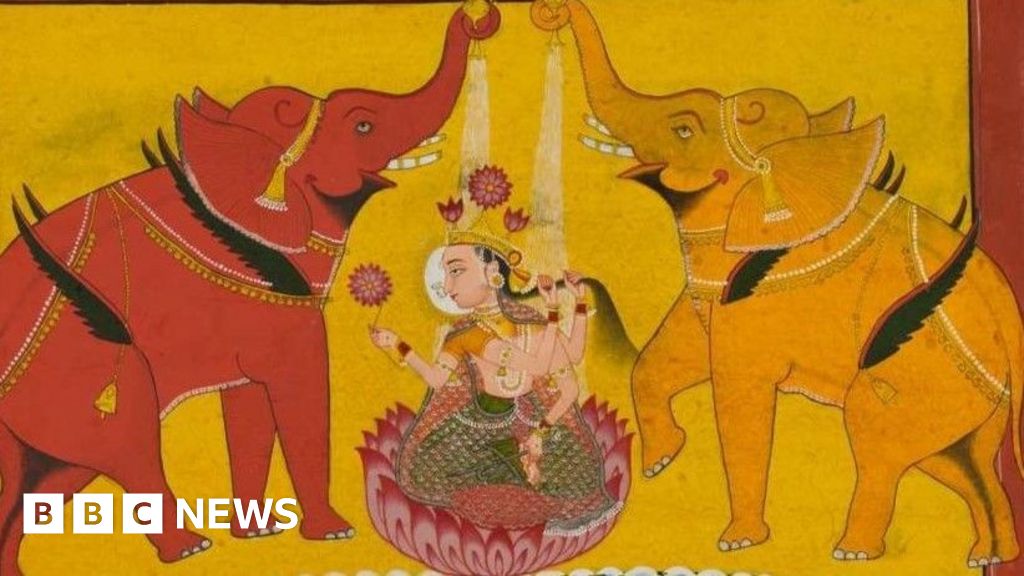Serpents to saints: The fascinating journey of India's spiritual art
圣徒的蛇:印度精神艺术的迷人之旅
20 June 2025 Share Save Nikhil Inamdar • @Nik_inamdar BBC News, London Share Save
2025年6月20日共享保存nikhil inamdar•@nick_inamdar BBC新闻,伦敦分享保存
The Trustees of the British Museum Gouache painting on paper depicting goddess Lakṣmi
大英博物馆的受托人在纸上描绘女神lakṣmi的纸上画
A new exhibition at the British Museum in London showcases the rich journey of India's spiritual art. Titled Ancient India: Living Traditions, it brings together 189 remarkable objects spanning centuries. Visitors can explore everything from 2,000-year-old sculptures and paintings to intricate narrative panels and manuscripts, revealing the stunning evolution of spiritual expression in India. Art from the Indian subcontinent underwent a profound transformation between 200BC and AD600. The imagery which depicted gods, goddesses, supreme preachers and enlightened souls of three ancient religions - Hinduism, Buddhism and Jainism - was reimagined from symbolic to more recognisably deriving from human form. While the three religions shared common cultural roots - worshipping ancient nature spirits such as potent serpents or the feisty peafowl - they negotiated dramatic shifts in religious iconography during this pivotal period which continues to have contemporary relevance two millennia apart."Today we can't imagine the veneration of Hindu, Jain or Buddhist divine spirits or deities without a human form, can we? Which is what makes this transition so interesting," says Dr Sushma Jansari, the exhibition's curator. The exhibition explores both the continuity and change in India's sacred art through five sections, starting with the nature spirits, followed by sub-sections dedicated to each of the three religions, and concluding with the spread of the faiths and their art beyond India to other parts of the world like Cambodia and China.
伦敦大英博物馆的新展览展示了印度精神艺术的丰富之旅。标题为“古代印度:生活传统”,汇集了189个跨越几个世纪的非凡物体。参观者可以探索从2,000年历史的雕塑和绘画到复杂的叙事面板和手稿的所有内容,从而揭示了印度精神表达的惊人演变。印度次大陆的艺术经历了200BC和AD600之间的深刻转变。描绘了三种古代宗教的神灵,女神,最高传教士和开明的灵魂的图像 - 印度教,佛教和Jainism-从象征性地重新构想,从人类形式衍生出更加公认的。尽管这三种宗教共有共同的文化根源 - 崇拜古老的大自然精神,例如有效的蛇或狂热的豌豆 - 他们在这个关键时期谈判了宗教肖像画的剧烈转变,这在现代相关性中持续了两千年。展览的策展人Sushma Jansari博士说:“今天,我们无法想象没有人类的印度教,Ja那教或佛教神灵或神灵的崇拜,我们可以吗?是什么使这种过渡如此有趣。”该展览通过五个部分探索了印度神圣艺术的连续性和变化,从自然精神开始,然后是专门针对三种宗教的每个部分,并以信仰及其艺术在印度以外的地方传播到世界其他地区,例如柬埔寨和中国。
The Trustees of the British Museum This panel - from a sacred shrine in Amaravati (in India's south-east) - was once part of the decorative circular base of a stupa
大英博物馆的受托人这个小组 - 来自阿马拉瓦蒂(Amaravati)的神圣神社(在印度东南部) - 曾经是佛塔的装饰性圆形基地的一部分
The Trustees of the British Museum This gold reliquary from about the 1st Century might represent the earliest dateable image of the Buddha shown as a man
大约1世纪的大英博物馆的受托人可能代表着最早的佛陀图像
The centrepiece of the Buddhist section of the exhibition – a striking two-sided sandstone panel that shows the evolution of the Buddha - is perhaps the most distinguishable in depicting this great transition. One side, carved in about AD250, reveals the Buddha in human form with intricate embellishments, while on the other - carved earlier in about 50-1BC - he's represented symbolically through a tree, an empty throne and footprints. The sculpture - from a sacred shrine in Amaravati (in India's south-east) - was once part of the decorative circular base of a stupa, or a Buddhist monument. To have this transformation showcased on"one single panel from one single shrine is quite extraordinary", says Dr Jansari.
展览的佛教部分的核心是一个引人注目的双面砂岩面板,显示了佛陀的演变 - 在描绘这一伟大过渡的情况下可能是最明显的。一侧大约在公元250年雕刻,揭示了人类形式的佛陀,并带有复杂的点缀,而另一侧则在大约50至公元前刻有雕刻 - 他通过树,一个空的宝座和足迹象征性地表示。该雕塑 - 来自阿马拉瓦蒂(Amaravati)的神圣神社(在印度东南部) - 曾经是佛塔的装饰圆形基地或佛教纪念碑的一部分。Jansari博士说,在“一个神社的一个单一面板上展示了这种转变”,这是非常非凡的。
The Trustees of the British Museum The figure resembles both a yakshi - a nature spirit - and a Hindu deity, a pivotal moment during the 1st Century in artistic representation
大英博物馆的受托人这个人物既类似于Yakshi - 一种自然精神 - 也类似于印度教神灵,这是1世纪的艺术代表时期的关键时刻
In the Hindu section, another early bronze statue reflects the gradual evolution of sacred visual imagery through the depiction of goddesses. The figure resembles a yakshi - a powerful primordial nature spirit that can bestow both"abundance and fertility, as well as death and disease" - recognisable through her floral headdress, jewellery and full figure. But it also incorporates multiple arms holding specific sacred objects which became characteristic of how Hindu female deities were represented in later centuries.
在印度教区域中,另一个早期的铜像雕像通过描绘女神来反映神圣的视觉图像的逐渐演变。该数字类似于Yakshi - 一种强大的原始自然精神,可以通过她的花朵头饰,珠宝和完整的身材来识别,可以赋予“丰富和生育和死亡和疾病”。但是,它还结合了多个武器,持有特定的神圣物体,这是印度女性在后来几个世纪中如何代表的特征。
The Trustees of the British Museum Jain religious art focuses on representations of the 24 enlightened teachers called tirthankaras. This one on sandstone is from AD200-300
大英博物馆Ja那教宗教艺术的受托人着重于24位开明的教师Tirthankaras的代表。这是砂岩上的AD200-300
On display also are captivating examples of Jain religious art, which largely focus on its 24 enlightened teachers called tirthankaras. The earliest such representations were found on a mottled pink sandstone dating back about 2,000 years and began to be recognised through the sacred symbol of an endless knot on the teachers' chest.
展出的还吸引了Ja那教宗教艺术的例子,这些例子主要集中在其24位开明的教师Tirthankaras。最早的表现是在约2,000年的斑驳的粉红色砂岩上发现的,并开始通过教师胸口无尽结的神圣象征得到认可。
Ashmolean Museum, University of Oxford This show has 40 pieces on loan from 37 museums and libraries around the world, including this head of a grimacing yaksha - a powerful nature spirit
牛津大学的阿什莫莱亚博物馆(Ashmolean Museum),该节目有40张来自世界各地37个博物馆和图书馆的借来,包括这位灰色的Yaksha的负责人 - 强大的自然精神
The sculptures commissioned across these religions were often made in common workshops in the ancient city of Mathura which the curators say explains why there are marked similarities between them. Unlike other shows on South Asia, the exhibition is unique because it is the"first ever" look at the origins of all three religious artistic traditions together, rather than separately, says Dr Jansari. In addition, it carefully calls attention to the provenance of every object on display, with brief explanations on the object's journey through various hands, its acquisition by museums and so on. The show highlights intriguing detail such as the fact that many of the donors of Buddhist art in particular were women. But it fails to answer why the material transformation in the visual language took place."That remains a million-dollar question. Scholars are still debating this," says Dr Jansari."Unless more evidence comes through, we aren't going to know. But the extraordinary flourishing of figurative art tells us that people really took to the idea of imagining the divine as human."
在古老的马图拉(Mathura)的普通研讨会上,策展人经常在策展人的讲习班中进行,策展人说,为什么它们之间有明显的相似之处。Jansari博士说,与南亚的其他演出不同,展览是独一无二的,因为它是“有史以来的第一个”来探讨所有三种宗教艺术传统的起源,而不是分开的。此外,它仔细地引起人们对展出每个物体的出处的关注,并简要说明了该物体通过各种手的旅程,博物馆的收购等。该节目强调了有趣的细节,例如,尤其是佛教艺术的许多捐助者都是女性。但是它无法回答为什么视觉语言中的物质转换发生的原因。Jansari博士说:“这仍然是一个百万美元的问题。学者们仍在辩论这一点。”“除非有更多证据得到解决,否则我们不会知道。但是,象征性艺术的非凡繁荣告诉我们,人们确实将想象神圣作为人类的想法。”
The Trustees of the British Museum The exhibition aims to give visitors a multi-sensory experience, with scents, drapes, nature sounds and vibrant colours
大英博物馆的受托人展览旨在为游客带来多敏感的体验,并具有气味,窗帘,自然声音和鲜艳的色彩
The show is a multi-sensory experience - with scents, drapes, nature sounds, and vibrant colours designed to evoke the atmospherics of active Hindu, Buddhist and Jain religious shrines."There's so much going on in these sacred spaces, and yet there's an innate calm and serenity. I wanted to bring that out," says Dr Jansari, who collaborated with several designers, artists and community partners to put it together.
该节目是一种多感觉的体验 - 带有气味,窗帘,自然声音和鲜艳的色彩,旨在唤起活跃的印度教,佛教和Ja那教宗教神社的气氛。Jansari博士说:“这些神圣的空间在这些神圣的空间中发生了很多事情,但是有一个天生的平静和宁静。我想带出来。” Jansari博士说。
The Trustees of the British Museum From about 3rd Century BC, Buddhist missionaries took their devotional art beyond India to countries like China
大英博物馆的受托人从公元前大约3世纪,佛教传教士将其虔诚的艺术带到了印度之外

